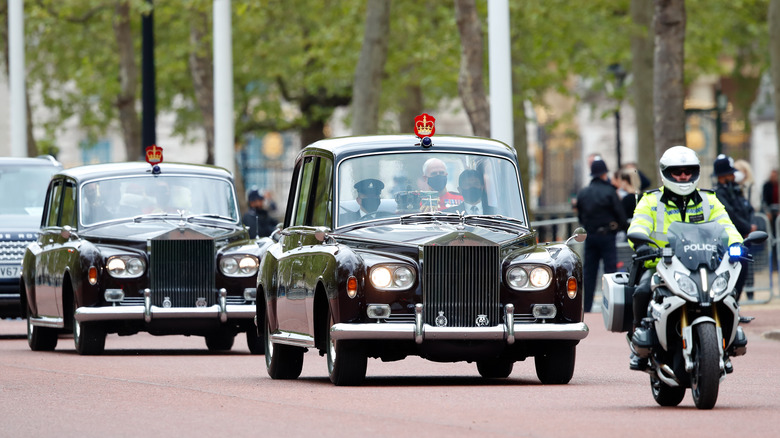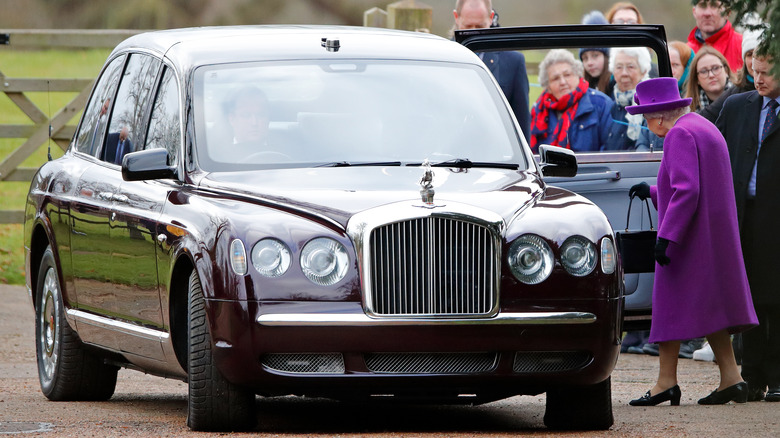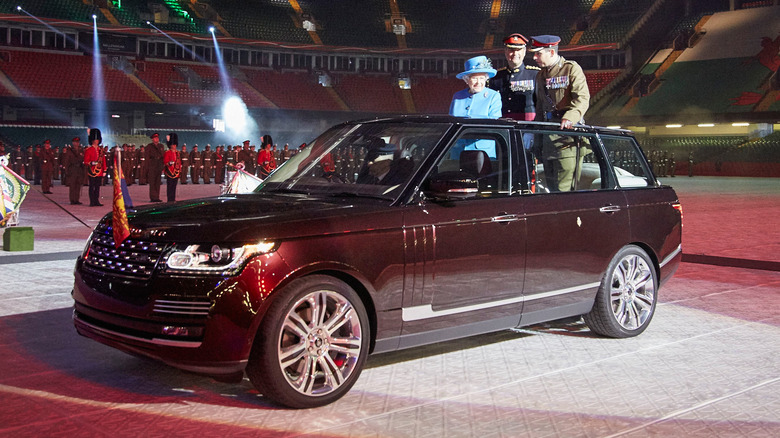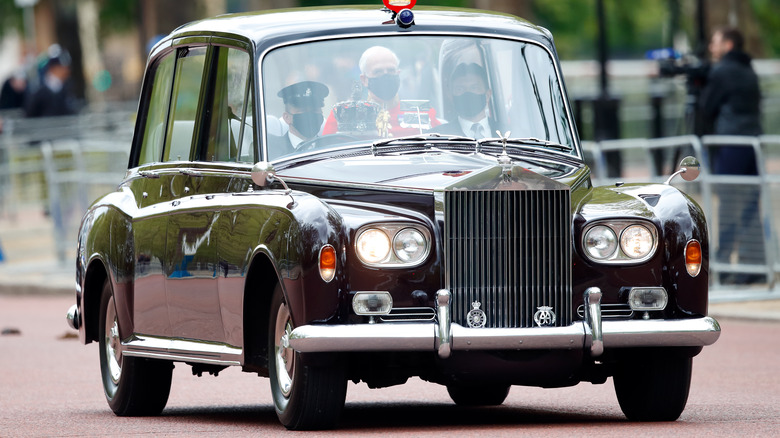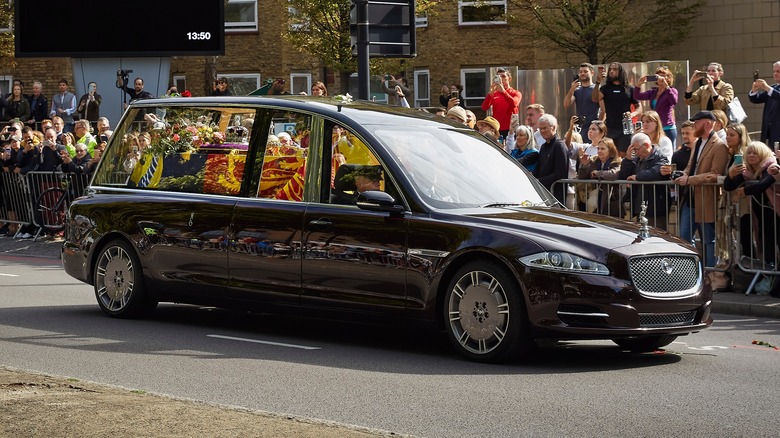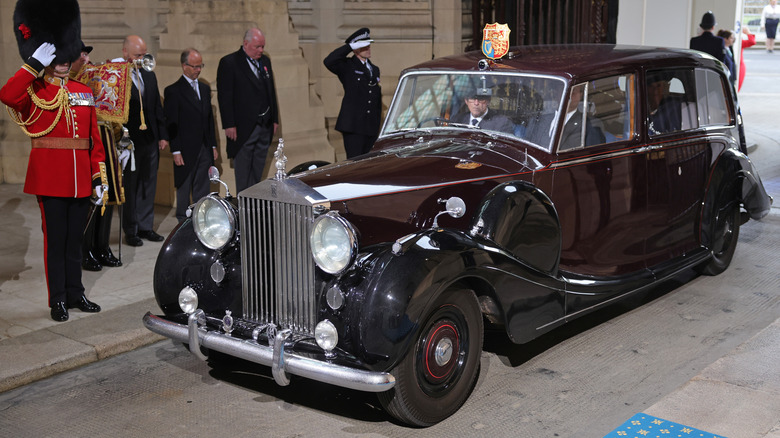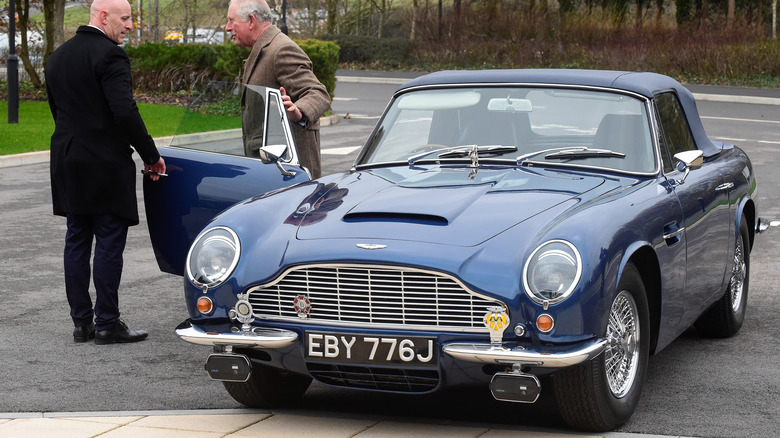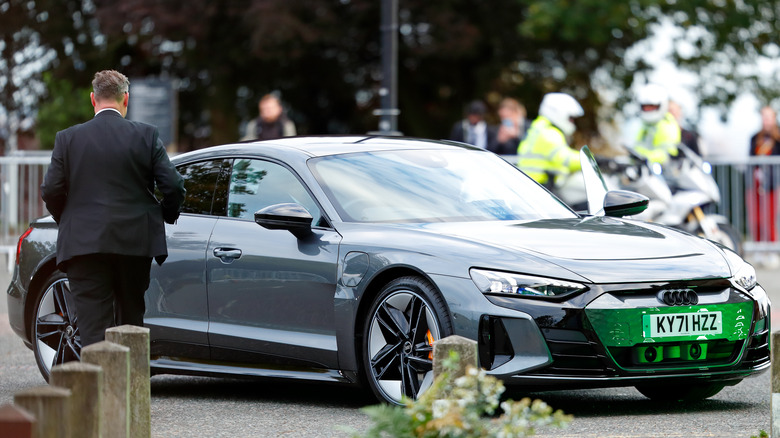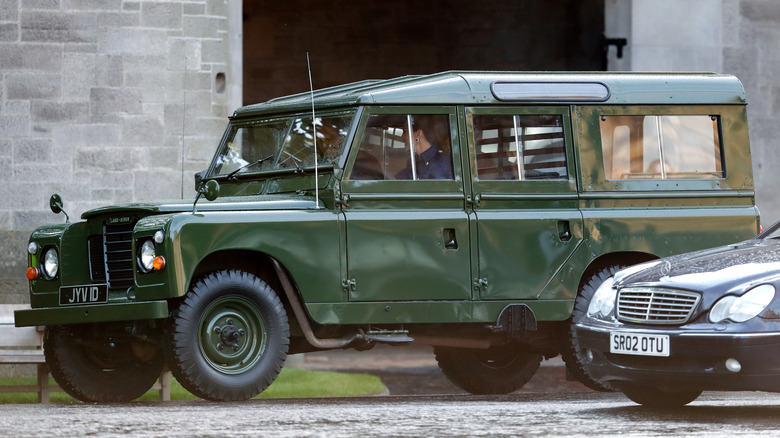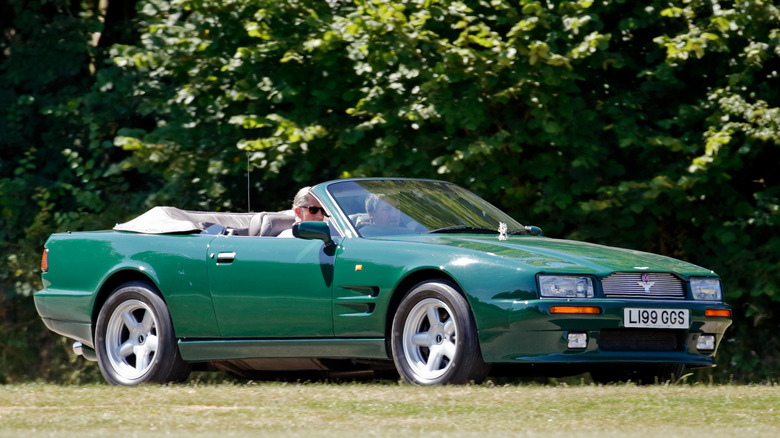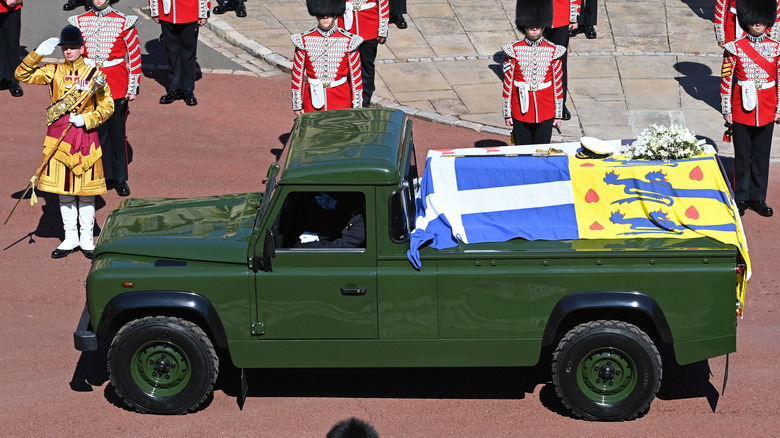The Rarest Cars Owned By The Royal Family
It's fair to say that 2022 has been a tumultuous year for the British Royal family. There was the lingering fallout from the Prince Andrew scandal, the ongoing conspiracy theories surrounding Meghan Markle, and of course, the death of HM Queen Elizabeth II. Upon her death, King Charles III ascended to the throne, marking the beginning of a new era for the family. Throughout his life, Charles has established himself as a keen environmentalist and has been critical in bringing global awareness to pioneering projects aiming to improve the environment (via National Geographic). He's also a notable car enthusiast and has taken steps to reduce the carbon footprint of his collection, including converting his Aston Martin to run on waste from cheese and wine manufacturing.
Many of the vehicles in the Royal car collection were built for HM Queen Elizabeth II, and now that Charles is king, it's unclear whether he'll keep all of them in active service. His push for eco-friendly transport has already seen him favor EVs and biofuel-powered cars over the family's traditional gas-powered ones, so we might well see some new electric state vehicles over the coming years. It's unlikely that Charles will retire all of the family's classic collection though, especially since there are plenty of insanely rare cars and even entirely custom creations sitting in the Royal garage.
Bentley State Limousine
A one-off created solely for HM Queen Elizabeth II, the Bentley State Limousine was designed with input from the Duke of Edinburgh, Her Late Majesty's head chauffeur, and Her Late Majesty herself (via Bentley). It was based on a Bentley Arnage, but it featured a unique panoramic glass house design to give onlookers a clearer view of the Queen. The rear door was designed to be tall enough that she could step in and out of the car without the need to stoop, and a unique monocoque construction was employed to ensure that the floor was completely flat for easy access.
The rear seats of the car where the Queen sat were upholstered with lambswool cloth from boutique British textile manufacturer Hield Brothers, with the rest of the car furnished in Bentley's own light gray leather. To protect the car's occupants from attacks, the bodywork and glass were strengthened (and presumably made bulletproof, although Bentley doesn't specify this), and the cabin could be sealed air-tight in case of a gas attack. The tires were also reinforced with Kevlar to ensure that they weren't vulnerable to slashing or bullets. The Royal Family is still in possession of the State Limousine, but since it was specially commissioned for HM Queen Elizabeth II herself, it's possible that it will now be retired after her death.
Land Rover Range Rover State Review 4
Unveiled in 2015, the fourth State Review Range Rover was another one-off vehicle commissioned specially for HM Queen Elizabeth II (via Land Rover). Based on a long-wheelbase Range Rover, the State Review 4 featured a hybrid diesel-electric powertrain, which allowed the car to run on purely electric power for short periods of time. The State Review line of cars goes back all the way to 1953 when the company provided the former Queen with a Land Rover Series I.
The most unique feature of the State Review 4 is the open platform at the rear of the car, which allows Royal occupants to stand above the roofline and greet their subjects. The car was first used when Queen Elizabeth presented New Colors to the Royal Welsh Regiment at an event in Cardiff, Wales, and it's only been used sparingly since. Much like the State Limousine, there are questions surrounding the future of the vehicle now that she has passed away, and at the time of writing, it hasn't been used for any Royal engagements by King Charles III.
Rolls-Royce Phantom VI
You could argue that the Phantom VI is the Rolls-Royce of Rolls-Royces. Just 374 examples of the car were built between 1968 and 1991, each one with unique bodywork and an interior designed to accommodate the exacting wishes of its owner (via BMW Classic). Each car was fitted with a 6.2L or 6.75L V8 engine, which the marque famously described as having "adequate" power. Experts reckon that actually translated to around 220 horsepower, hardly world-beating but more than enough for wafting along a London street (via Top Gear).
The Royal Family's Phantom VI was delivered in 1977 to celebrate Her Late Majesty's Silver Jubilee, and it featured a few unique modifications. The license plates were removed as the British Head of State does not require them by law, and the usual Spirit of Ecstasy on the front was replaced by a model of St George, the patron saint of England. However, the interior was mostly standard, with plush carpet, fine leather, and a full air conditioning system to keep Queen Elizabeth cool on those rare sunny days in Britain.
Jaguar XJ Hearse
HM Queen Elizabeth II's funeral in September 2022 became one of the most-watched events of the year, with over 29 million people tuning in to watch in the U.K. alone (via The Guardian). During the funeral, the Queen's coffin was transported by a Jaguar XJ hearse that was designed in part by the late Monarch herself. It was first used to pick the coffin up from RAF Northolt to Buckingham Palace, and then again to drive the coffin from London to Windsor, her final resting place (via ITV).
Much like her Bentley State Limousine, the Jaguar hearse was designed to give onlookers a clear view of the Queen's coffin during its final procession, and like her Phantom IV, the hood ornament depicted St George slaying a dragon (via The Drive). The hearse was painted Royal Claret, a unique shade that's reserved for official State vehicles only. No official description was given of the protective measures taken to ensure the Queen's coffin was kept safe, but we can assume that the car was just as heavily armored as the rest of Her Late Majesty's fleet.
Rolls-Royce Phantom IV
Originally, the Phantom IV was intended to be a one-off designed exclusively for then-Princess Elizabeth and her new husband the Duke of Edinburgh, but in the end, a total of 18 examples would be produced (via Autocar). There was no way to simply buy one of these cars from Rolls-Royce – instead, buyers had to be either a member of the British Royal family or heads of state of another country. Autocar reports that Generalissimo Francisco Franco of Spain and King Faisal II of Iraq were two of the other owners deemed worthy of such a car. Strangely enough, though, one Phantom IV didn't end up in the hands of a world leader, but rather it ended up being used as a truck at Rolls-Royce's factory in Crewe.
The Phantom IV was the first specially-designed Rolls-Royce for the Royal family and the first time that the company had designed an entirely new model at a single owner's request (via BMW Classic). The Royals ended up buying multiple examples of the car for various family members and official duties. Some of those Phantom IVs have since been sold off – Queen Elizabeth II sent her personal car to auction in 2018 – but at least one example is believed to still be in the Royal garage, namely the one that transported Meghan Markle on her wedding day (via Motor1).
Aston Martin DB6
Before he became King Charles III, then-Prince Charles was known for his pioneering attitude towards sustainability (via Aston Martin Magazine). This stretched to his car collection, and in an effort to reduce his carbon footprint, he decided to convert his beloved Aston Martin DB6 Volante to run on biofuel made from wine and cheese. This cutting-edge technology was developed by U.K.-based Green Fuels, who take wine that's been deemed unsuitable for human consumption and combine it with whey, a by-product of cheese production. This unusual blend is processed into E85 fuel, which thanks to its high octane content, actually makes the DB6 more powerful than when it ran on regular gasoline, according to Aston Martin.
Green Fuels now has a Royal Warrant of Appointment to supply King Charles, and is reportedly working on a way of bringing sustainable aviation fuel to commercial markets using similar methods. While, in many ways, Charles fits the pompous, old-world image that the Royal family has carefully cultivated over the decades, his cutting-edge Aston Martin proves he's also an innovator as well as a traditionalist.
Audi RS e-tron GT
His father King Charles III might have made his name as the first eco-pioneer within the Royal family, but it seems that Prince William is keen to follow in his Dad's footsteps. He arrived to present the inaugural Earthshot Prize in a brand-new Audi RS e-tron GT, which produces 598 horsepower through two electric motors (via Autoevolution). Earthshot Prize is a non-profit organization that will award $70 million to projects that improve the environment, and it's personally backed by the Duke of Cambridge.
His newest automotive acquisition is reportedly part of a plan to modernize the entire fleet of Royal vehicles, with a project underway to install electric fast charging points at all of the Royal estates. King Charles will surely be pleased, as he already owns an electric Jaguar I-Pace, and he's recently been seen being chauffeured in an Audi e-Tron SUV. Clearly, the electric revolution is already well underway in the Royal household.
Land Rover Series 2a
The Royal family and Land Rover have a connection that goes back decades, and most members of the family have owned one at some point or another. In 2021, the Duke and Duchess of Cambridge drew headlines when they arrived at a drive-in cinema in a Land Rover Series 2a that formerly belonged to the late Prince Philip (via The Scotsman). The event was organized to celebrate the efforts made by NHS (National Health Service) staff during the Covid-19 pandemic, so it was fitting that the Cambridges arrived in their most "down-to-Earth" car.
As television presenter Ben Fogle pointed out in an article for The Telegraph, old Land Rovers are objectively terrible cars to drive, being unreliable, creaky, and slow. Yet, they occupy a place in British national consciousness that no other vehicle does being driven by everyone from farmers to celebrities and, evidently, by royalty as well.
Aston Martin Virage Volante
Although it's no longer under King Charles' care, his former Aston Martin Virage Volante remains one of his most iconic vehicles. The car was never actually bought by the Royal family, but rather leased for 15 years directly from Aston Martin, with the then-Prince returning it in 2008 (via Tatler). The car was originally supplied with a 5.2L engine, but at Charles's request, it was later upgraded to a 6.3L unit. The car was also fitted with a police radio so that Charles could directly talk to his security escort, but that feature was removed after the car was returned to Aston Martin.
Charles was clearly very fond of the car, as data from its MOT test (a roadworthiness test that's required for all British vehicles less than 40 years old) shows it had over 33,000 miles on the odometer by the time it was given back. It was eventually put up for sale in 2019 for the price of £275,000 (roughly $349,250 at the time), and it's now in the hands of an unknown private buyer. The Virage Volante was the newest Aston Martin that Charles has had in his personal collection, but in 2020, he helped put the finishing touch on a new DBX that was being constructed at the brand's factory (via Autoblog). He even got to drive the car, but tellingly, chose not to order one of his own.
Land Rover Defender Hearse
If there's one thing you could say for certain about the Royal family, it's that they don't like to leave things to chance. Prince Philip took this ethos to heart with his choice of hearse, which he reportedly began working on a full 16 years before he needed to use it (via BBC). His custom Land Rover Defender hearse, painted a shade of military green, included a stretched open rear section where his coffin rested, along with various fixings to keep it firmly in place during transit.
The Defender is a tribute to the Prince's military past, with a plain black front grille, green painted wheel hubs that match the car's exterior, and a simple single cab design. The car played an especially big part in Philip's funeral as lockdown restrictions at the time meant that only 30 people were allowed to attend the service in person. So, for millions of home-bound viewers as well as foreign dignitaries, Royal staff and even the Prince's old friends, watching on television as his coffin was driven on the back of his Land Rover was the closest they got to being able to say goodbye to him.
